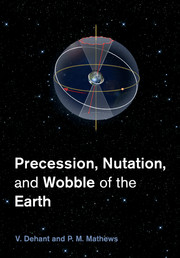Book contents
- Frontmatter
- Contents
- Preface
- List of abbreviations
- 1 Introduction – Fundamental definitions – Motivation
- 2 Concepts and elementary theory
- 3 Reference systems and frames
- 4 Observational techniques – ephemerides
- 5 Rigid Earth precession and nutation
- 6 Deformable Earth – Love numbers
- 7 Nutations of a non-rigid Earth
- 8 Anelasticity
- 9 Ocean and atmospheric corrections
- 10 Refinements of non-rigid nutation
- 11 Comparison observation-theory
- 12 Conventions
- 13 Mars nutations
- Appendix A Rotation representation
- Appendix B Clairaut theory
- Appendix C Definitions of equinoxes
- Bibliography
- Index
3 - Reference systems and frames
Published online by Cambridge University Press: 05 May 2015
- Frontmatter
- Contents
- Preface
- List of abbreviations
- 1 Introduction – Fundamental definitions – Motivation
- 2 Concepts and elementary theory
- 3 Reference systems and frames
- 4 Observational techniques – ephemerides
- 5 Rigid Earth precession and nutation
- 6 Deformable Earth – Love numbers
- 7 Nutations of a non-rigid Earth
- 8 Anelasticity
- 9 Ocean and atmospheric corrections
- 10 Refinements of non-rigid nutation
- 11 Comparison observation-theory
- 12 Conventions
- 13 Mars nutations
- Appendix A Rotation representation
- Appendix B Clairaut theory
- Appendix C Definitions of equinoxes
- Bibliography
- Index
Summary
Celestial and terrestrial reference systems and frames
The term “reference systems” applies to the conceptual basis for the definition of “reference frames.” The “frames” are realizations of the “systems” with the aid of the best available observations.
Celestial reference systems have their axes defined in relation to objects in space; terrestrial reference systems have axes that are fixed to the Earth, and hence rotating in space. All geocentric reference systems are taken to have a common origin.
3.1.1 Equator, ecliptic, and equinox, and their motions
The motion of an Earth-related axis in space is accompanied by a corresponding motion of the equator of that axis in space. These motions are manifestations of lunisolar precession and nutation. The instantaneous position of the equator resulting from just the secular part of the motion, namely precession, is the mean equator of date, while the true equator of date is the actual instantaneous position of the equator which includes the effect of nutation too. The true/mean equator of epoch (e.g., J2000) represents the position occupied by the true/mean equator at that fixed epoch.
The ecliptic, the plane of the orbit of the Earth–Moon barycenter around the Sun, was introduced in the previous chapters (Chapters 1 and 2, see also Appendix C) while defining precession (see Section 1.3). The plane of the ecliptic does not remain strictly fixed: it undergoes a slow rotation in space about an axis lying in this plane. This rotation is caused by the gravitational pulls exerted on the Earth–Moon system by the other planets. Therefore, the ecliptic at any given instant, known as the ecliptic of date, differs from the ecliptic of J2000 (or other fixed epoch). It is important to recognize that the secular (precessional) part of the motion of the Earth's axis at any instant is around the normal to (i.e., parallel to) the ecliptic of date (see Fig. 3.1). Therefore the direction of the precessional motion in space undergoes a slow variation as the ecliptic plane rotates in space; and the rate of precession gets a small contribution from the motion of the ecliptic.
- Type
- Chapter
- Information
- Precession, Nutation and Wobble of the Earth , pp. 77 - 95Publisher: Cambridge University PressPrint publication year: 2015



